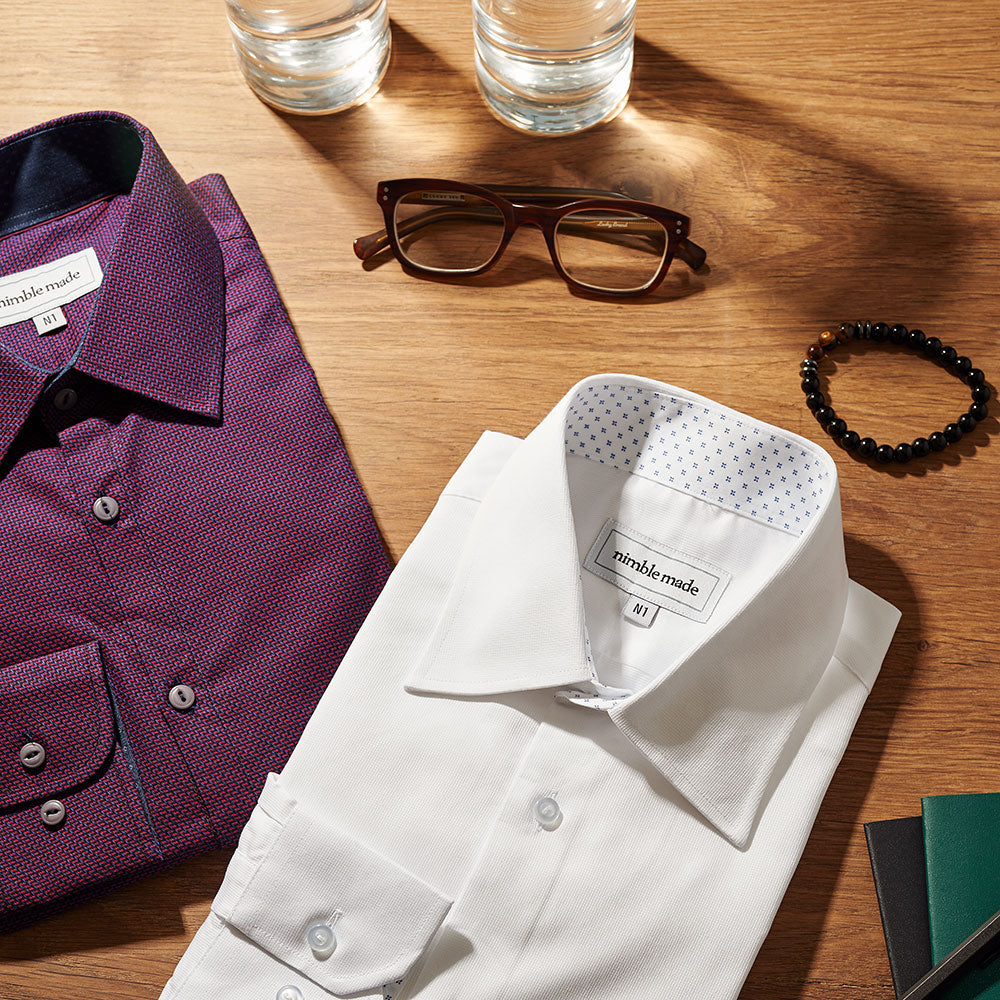
Today’s fashion world is fraught with perilous choices. The dress shirt, sport shirt and casual shirts have all started looking very similar. While it’s obvious when to skip the t-shirt and go for a nicer buttoned shirt, it can be more difficult to navigate just how far to take the formality these days.
Never fear, this article will serve as your authoritative guide to the world of men’s fashion. What’s the difference between semi-formal vs formal, dress, and sporty? When do you wear which look? Find out all the answers now!
| Dress Shirt | Casual Shirt |
|---|---|
 |
 |
|
|
Shirt Types
The first thing you need to know about is the most common types of shirts. There are formal dress shirts, business casual shirts, smart casual and sporty shirts. Each one is worn on different occasions. It’s pretty easy to tell formal shirts apart but the others can get a bit confusing when it come to the rules.
Formal
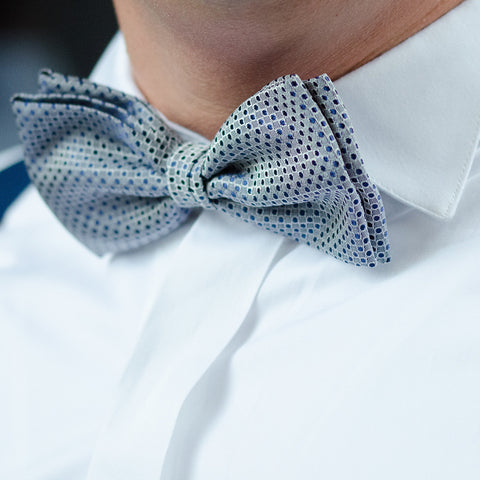
Formal shirts, or tuxedo shirts, are long sleeve, button-up shirts with a short tipped collar meant to be worn with a bowtie. Often paired with a suit, these are the dressiest of all dress shirts in menswear and rarely worn outside of black-tie galas. Try a combination of blue suit brown shoes.
Dress Shirt
The dress shirt is a fashion staple. It can be dressed down into casual looks, but it was not made for this purpose. It’s a semi-formal (business) type shirt. It’s extremely common and comes in a variety of collar and cuff types and styles like the club collar.

These are long sleeved, button up shirts. They are worn at work, during business meetings or at nicer events. Dress shirts are typically worn solo, over an undershirt, or under jackets. They are very versatile and can be worn to church, weddings, proms, and interviews.
Here's a guide on how to wash dress shirts and how to buy a dress shirt.
Adding a tie and jacket adds formality, but they are often worn without for a business casual look like the ones from Nimble Made:
At Our Dress Shirt Brand RankingsSport Shirt
The sport shirt is not actually your favorite workout tee. This is a very distinctive style of shirt that originated with the Brooks Brothers and became quite popular in England. They are commonly Oxford cloth button-down shirts and are usually less stiff in the collar than dress shirts and come in bolder patterns and colors.
These are great options for casual wear, turning jeans into something sharper than just jeans and a tee. These can be worn with everyday wear or to the country club for a day of golf. (Are jeans business casual? Read this guide to find out.)

A very popular variant of the sports shirt is the business casual polo shirt. This is often seen in golf and tennis sportswear. These don’t button down all the way, but they do have a collar.
They’re usually made of knits rather than woven materials, so they’re very comfortable and pretty breathable. They’re also great to wear at country clubs or in environments where you are playing sports but still need to look nice.
How Should Your Shirt Fit?
Now that you know the difference between the 4 major types of men’s shirts and when to wear each type, let’s make sure you know the right fit for your body. The fit of a shirt can quickly make even the most formal shirt look sloppy, or make the casual ones look sharp and on point.
Sizes and Measurements
The 2 basic measurements for men’s dress shirts are the neck and sleeve sizes. These measurements estimate the proper size you need. The measurements are usually in inches or cm for European fits.
For help transitioning, an American 15’’ neck is around a 38 in European sizing. Casual and sporty shirts tend to come in standardized S, M, L, XL sizing. At Nimble Made, we believe height and weight tend to offer a much better size than traditional neck and sleeve measurements that are outdated.

You want your collar to be tight but not to choke you or restrict airways. Remember that in dress situations you will be adding a tie. Your sleeve length should come anywhere from just above your wrist to just at your wrist. Here's a guide on how to correctly measure your sleeve length. It should never extend past the meaty part of your hand and into your palm.
The exception to longer cuffs is in a more casual look, where you fold the cuff over a jacket or sweater sleeve. Here's how we'd recommend wearing a sweater over a dress shirt.
Shirt Length
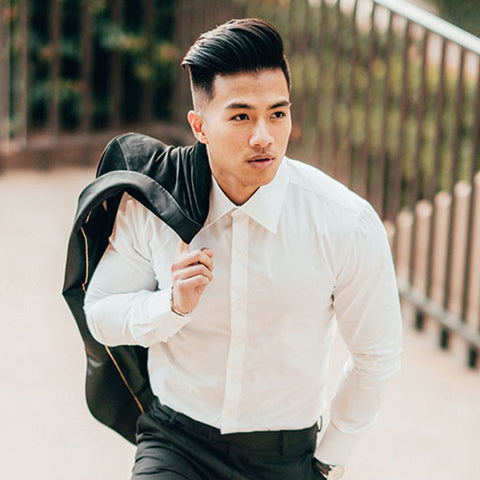
The shirt length is telling when it comes to dressy shirts versus casual ones. Dress shirts are made longer because they’re meant to be tucked into pants. They need to have some length to allow you to move or dance without coming untucked.
Sporty and casual shirts have lower side seams and the shirt tail is shorter, so that you can wear them untucked without looking like you a dress. An untucked shirt should never extend lower than the bottom of your back pocket. If it’s much shorter than the middle of that same pocket, you may end up showing some midriff if you move a lot.
Frame
The frame of your shirt shouldn’t change much between dress and sports shirts. It should offer plenty of room for you to stretch your back and shoulders and raise your arms. It should taper into your torso while sticking close to the hips (but not so close it’s skin tight). Here are guides on how to measure your waist and how to measure your hips.
You want your final button to close on your shirt without any gaps in the buttons or constraint to your hips, but you don’t want the shirt to be so loose that you are drowning in it and lose your shape. Basically, your shirt should conform to your natural body size without hugging it so tight you’re popping out of it.

Modern fit shirts tend to be tapered, meaning a chest diameter that narrows down the body and these work well on slim bodies. They curve inwards with your figure. A traditional fit will have a more straight down cut to it, it's able to accommodate rounder body types thanks to the extra room in the torso.
Try a few different cuts to see which one best suits your figure, but remember that all shirts are cut differently so they may not be the same fit from brand to brand. Use caution when it comes to the traditional cut because they can be like pillowcases – boxy and billowy. If that’s what your shirt looks like on you, then change it quickly!
Fabrics
The fabric of a shirt can indicate quickly what type of shirt it is. Elements like the material, the color, and the patterning can quickly take a shirt from formal to casual and vice versa regardless of the cut.
Dress Shirts
Dress shirts usually have tightly woven cotton or silk in very high thread counts. They are woven in forms like twill, oxford, textured, broadcloth or poplin, and pinpoint designs.
These are the ways shirt fabrics are woven into the shirt, with the most common dress shirt being an oxford and the emerging modern fashion favorite being twill. They always have long sleeves. Dress shirts with short sleeves aren't really considered dress shirts and are much less formal.
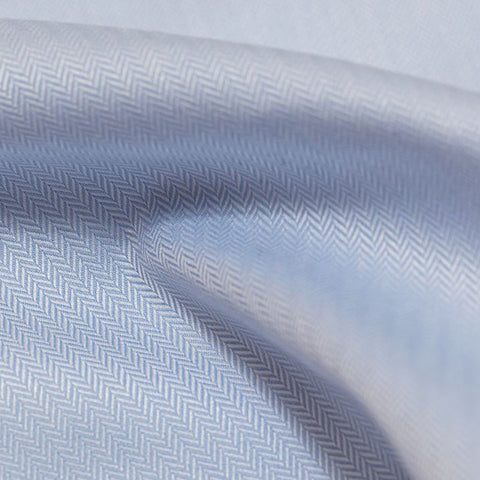
These types of shirts may be a bit shiny. This adds to the dressy appearance, giving them a way to stand out from the matte design of casual shirts.
Colors in dress shirts are usually understated. They range from white to black, but are almost always a solid color that isn’t too bright. Think white, grey, black, and navy (our recommend best black dress shirt here) The most popular colors tend to be pastels – soft and understated:
- Lighter blues
- pinks
- white
-
greens
Browse Our Best Selling Dress Shirts
Dressier shirts are occasionally found in bright jewel tones, but in general the flashy color can quickly send a shirt into the casual spectrum of looks unless you know exactly how to tone the bright colors down and make them more formal with darker jackets and formal ties.
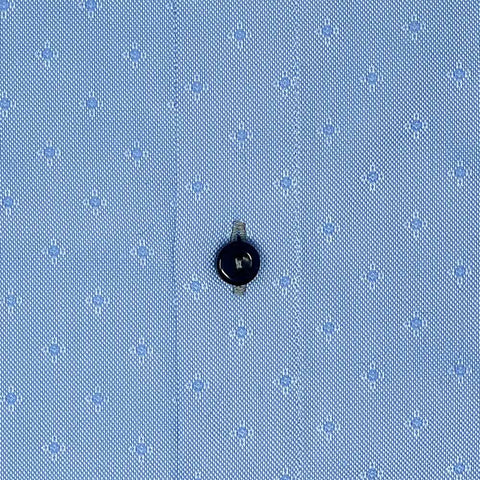
The exception to a plain pattern is a very subtle floral. The bolder floral patterns are casual, but a small floral or paisley pattern in a pastel color can often be found in dress shirts, especially in European fashion.
Dress shirts can also be striped, but there are rules. The stripes must be vertical. Horizontal stripes are casual by nature. They also have to be thin. Thicker stripes are for casual shirts. Most dress shirt stripes are less than half a centimeter thick.

The color should match without being too bold a contrast. Generally, a white shirt and very light blue shirt are the only 2 colors that you will see with stripes. White and navy is a common stripe combination. These blue dress shirts are must-have's in your closet.
Casual Shirts
With casual shirts, the weaves can be more rugged. These can come in plain oxford, linen, chambray, or even flannel and denim and be both short and long sleeves. These materials tend to be more breathable, easier to come by, and less glossy. They’ll be more relaxed materials that are less crisp and ironed.

If a shirt is plaid or gingham, then it is almost certainly a sport or casual shirt. If the shirt is short sleeved, even if it has buttons, it is a casual shirt. If it has more than 1 pocket… you guessed it! That’s a casual shirt.
These shirts are great for layering, and will often be mixed with tees and cardigans. They can be worn on their own and will look good tucked or untucked. They’re very versatile.

Casual shirts can come in pastels and plain colors, but typically the casual shirt is where you will find much bolder colors and patterns. Checkers, ginghams, and plaids are common, but so are large floral patterns, printed designs, diamonds, and more.
Pairing Tips
Our Selection of Dress Shirts
As a final word, remember that just because a shirt qualifies as a dress shirt does not make it dressy. If you are in a situation that requires formal dress, but you wear an untucked dress shirt with jeans and an unbuttoned collar, you may as well be wearing tennis shoes and an undershirt. This may be a great look, but it negates the dress factor.

The rest of your outfit makes a huge impact on whether your shirt is perceived as dressy or casual. Make sure that if you’re in a formal situation, you’re tucking in the shirt, belting the pants, and pairing a fitted jacket or blazer with some dress shoes or loafers. Here's how to fold your shirts for travel too.

If you’re in a casual situation but you still want to look stylish and stand out from the crowd, pairing your dress shirt with some dark wash fitted jeans, flat sneakers, and a cardigan or lighter colored blazer will do wonders to tone it down and turn it into a casual shirt.
FAQs
1. Whats the difference between a dress shirt and a casual shirt?
Since dress shirts are intended to be tucked into trousers, they are longer in length. The sleeves should be long enough to allow for movement and dancing without coming untucked. Shirts with lower side seams and a shorter shirt tail allow you to wear them untucked without appearing as if you are wearing a dress.
2. Can you wear dress shirts casually?
Yes. Feel free to experiment with vivid colors and patterns when wearing a casual dress shirt, and undo as many buttons as you feel appropriate for the occasion. Dress shirts should be untucked, so the length is important.
3. Is dress shirt formal?
Dress shirts, on the other hand, can be worn casually or semi-formally. Long-sleeved dress shirts are typically buttoned all the way up the arm. A dress shirt worn with a suit jacket and a tie is considered semi-formal; a dress shirt worn without a tie is also considered semi-formal.
4. What do you call a casual shirt?
Is a half-sleeved shirt called a half-sleeved shirt? Half-sleeved shirts are sometimes called camp shirts. It is similar to a button-down shirt and frequently has a full-length button closure on the front. It is an informal shirt, which is rarely tucked in.
5. Can you wear shirts casually?
Casual shirts strike the ideal balance between casual and formal attire. It is more formal than a tee shirt yet more relaxed than a jacket or blazer. You can also style it in a variety of ways. It can be worn with chinos, cuffed jeans, or trousers.



Comments (0)
Back to News